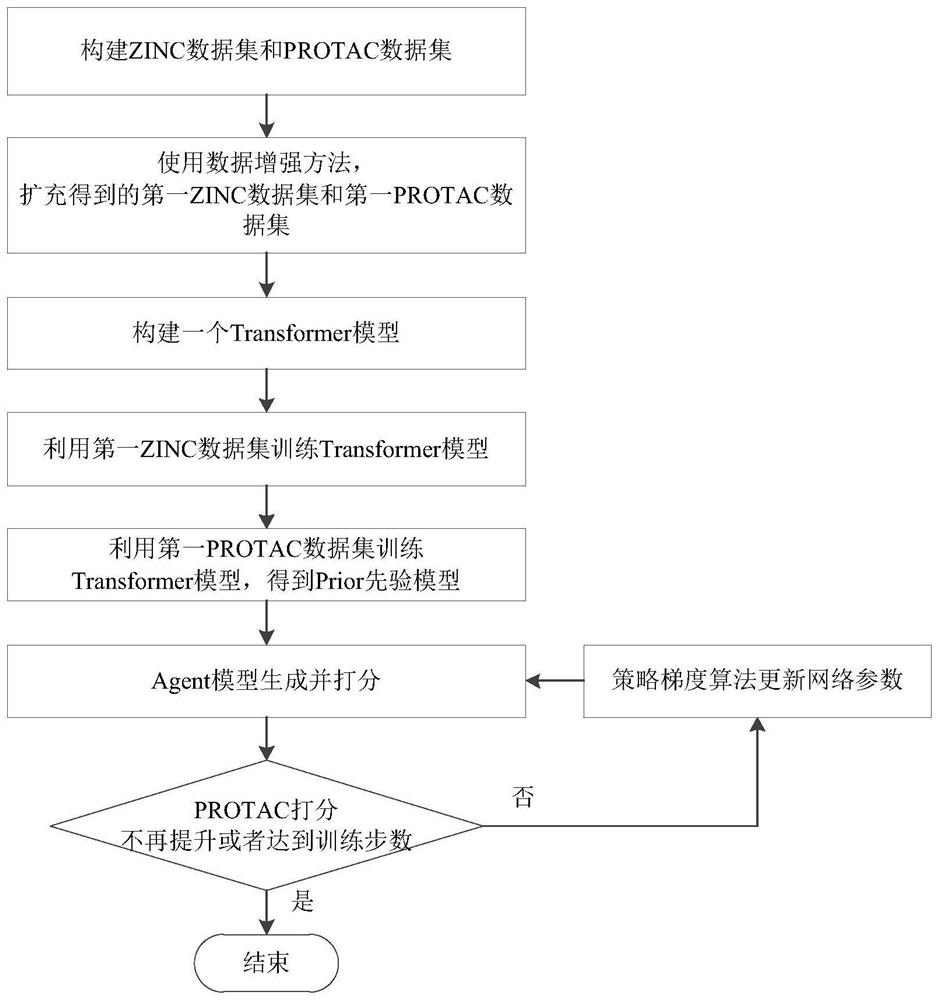Protein degradation targeted chimera connector generation method based on deep reinforcement learning
A technology of reinforcement learning and protein degradation, applied in the field of artificial intelligence and protein degradation targeting chimera design, can solve the problems of difficult generalization, inability to generate molecules, inability to use PROTAC design, etc., and achieve the effect of improving robustness
- Summary
- Abstract
- Description
- Claims
- Application Information
AI Technical Summary
Problems solved by technology
Method used
Image
Examples
Embodiment 1
[0053] Such as figure 1 As shown, a method for generating protein degradation targeting chimera linkers based on deep reinforcement learning, the method includes the following steps:
[0054] Construct the ZINC data set, as follows: download molecular SMILES with a molecular weight greater than 500 from the ZINC database, use the matching molecular pair cutting algorithm (MMPs) to cut the downloaded molecules, and obtain the first fragment SMILES containing cuts, linkers, Fragment Molecule Quadruples for Second Fragment SMILES, Whole Molecule Containing Cuts. If multiple quadruples are obtained by cleavage of the same molecule, only the quadruple with the longest linker is kept.
[0055] Subsequently, according to the properties of PROTAC warheads, linkers, E3 ligase ligands, and complete PROTACs, PROTAC-like molecules were screened from the ZINC database, and a ZINC data set was constructed, which contained about 220,000 PROTAC-like molecules.
[0056] The properties of the...
Embodiment 2
[0084] A computer system includes a memory, a processor, and a computer program stored in the memory and operable on the processor. When the processor executes the computer program, the steps of the method are as follows:
[0085] Use the data enhancement method to expand the constructed ZINC data set and PROTAC data set, and use the expanded first ZINC data set and the first PROTAC data set as a supervised training set;
[0086] Build a Transformer model and set the number of training steps, number of network layers, number of attention layers and optimizer parameters;
[0087] Use the first ZINC data set as input to train the Transformer model, and continuously update the parameter values of the Transformer model according to the objective function and backpropagation algorithm training;
[0088] Input the first PROTAC data set into the updated Transformer model, continue to use the above-mentioned objective function and the above-mentioned backpropagation algorithm to tra...
Embodiment 3
[0092] A computer-readable storage medium, on which a computer program is stored, and when the computer program is executed by a processor, the method steps implemented are as follows:
[0093] Use the data enhancement method to expand the constructed ZINC data set and PROTAC data set, and use the expanded first ZINC data set and the first PROTAC data set as a supervised training set;
[0094] Build a Transformer model and set the number of training steps, number of network layers, number of attention layers and optimizer parameters;
[0095] Input the first ZINC data set into the Transformer model, use the objective function and backpropagation algorithm to train, and continuously update the parameter values of the Transformer model;
[0096] Input the first PROTAC data set into the updated Transformer model, continue to use the above-mentioned objective function and the above-mentioned backpropagation algorithm to train, further update the network weight, transfer the Tr...
PUM
 Login to View More
Login to View More Abstract
Description
Claims
Application Information
 Login to View More
Login to View More - R&D
- Intellectual Property
- Life Sciences
- Materials
- Tech Scout
- Unparalleled Data Quality
- Higher Quality Content
- 60% Fewer Hallucinations
Browse by: Latest US Patents, China's latest patents, Technical Efficacy Thesaurus, Application Domain, Technology Topic, Popular Technical Reports.
© 2025 PatSnap. All rights reserved.Legal|Privacy policy|Modern Slavery Act Transparency Statement|Sitemap|About US| Contact US: help@patsnap.com



